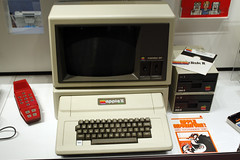Users and Technologies Before the Web
From the 1950s until the early 1990s, computers ("electronic brains") were introduced and gradually propagated outside corporate machine rooms and offices. Personal computers (PCs) became available to experimenters in the 1970s, and to a more general population in the 1980s. At first, these systems enabled interested hobbyists and other individuals to perform local tasks and to play local games. Some office workers had timesharing terminals or PCs to perform tasks like spreadsheet analysis and word processing.
Some hobbyists dialed into bulletin board systems (BBSs) or early commercial on-line services like Compuserve and America Online (AOL). Early dial-up service was adequate for command line interaction, but didn't enable more powerful graphical user interfaces (GUIs). A small community of ARPAnet and Internet researchers developed foundational networking technologies within a generally friendly and mutually trusting environment.
 Information Security History: A Virtual Overview
Information Security History: A Virtual Overview


